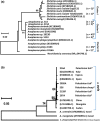Molecular characterization of Anaplasma and Ehrlichia in ixodid ticks and reservoir hosts from Palestine: a pilot survey
- PMID: 30762295
- PMCID: PMC6498520
- DOI: 10.1002/vms3.150
Molecular characterization of Anaplasma and Ehrlichia in ixodid ticks and reservoir hosts from Palestine: a pilot survey
Abstract
Tick-borne anaplasmosis and ehrlichiosis are clinically important emerging zoonoses usually overlooked by veterinarians and physicians alike. This study aimed at detecting and genetically characterizing Ehrlichia and Anaplasma species in ixodid ticks and their animal hosts from the West Bank, Palestine. A total of 723 ixodid ticks belonging to three genera (Rhipicephalus, Hyalomma, Haemaphysalis) were collected from dogs, sheep, goats and camels. In addition, 189 blood samples were collected from dogs, sheep, camels, horses and a goat from the West Bank, Palestine. All tick and blood samples were investigated for the presence of Anaplasma and Ehrlichia targeting a 345 bp fragment of the 16S rRNA gene followed by sequence analysis. The infection rate of Anaplasma spp. in ticks was 6.5% (47/723). Anaplasma platys was identified in 28% (13/47) of them. Whereas, based on a partial sequence (851 bp) of msp4 gene, 38% (18/47) were identified as A. ovis. The species of the remaining 16 positive samples (16/47, 34%) could not be identified. Simultaneously, the infection rate of Ehrlichia spp. in the ticks was 0.6% (4/723). Three of which were E. canis and one was Ehrlichia spp. The infection rate of A. platys in dogs' blood samples was 10% (13/135), while it was 1.5% (2/135) for E. canis. The infection rate of Anaplasma in sheep blood samples was 40% (19/47), out of which 26% (5/19) were caused by A. ovis as revealed by msp4-PCR. Implementation of purely-spatial analysis by saTScan for all cases of Anaplasma revealed two statistically significant clusters in two districts; Tubas town and Majdal-Bani-Fadil village on the western hills of the Jordan Valley. Most cases of Anaplasma (83%) were from rural areas where life cycle components (vector, host and reservoir) abundantly interact. This study is the first in Palestine to reveal the presence of Anaplasma and Ehrlichia in ticks, dogs and sheep providing crucial platform for future epidemiological surveys and control strategies in the country and region.
Keywords: Anaplasma; Ehrlichia; Ixodid ticks; Palestine; dogs; sheep.
© 2019 The Authors. Veterinary Medicine and Science Published by John Wiley & Sons Ltd.
Conflict of interest statement
The authors declare that the research was conducted without any conflict of interest.
Figures



References
-
- Aktas M., Altay K., Dumanli N. & Kalkan A. (2009) Molecular detection and identification of Ehrlichia and Anaplasma species in ixodid ticks. Parasitology Research 104, 1243–1248. - PubMed
-
- Al‐Adhami B., Scandrett W.B., Lobanov V.A. & Gajadhar A.A. (2011) Serological cross‐reactivity between Anaplasma marginale and an Ehrlichia species in naturally and experimentally infected cattle. Journal of Veterinary Diagnostic Investigation 23, 1181–1188. - PubMed
-
- Aubry P. & Geale D.W. (2011) A review of bovine anaplasmosis. Transboundary and Emerging Diseases 58, 1–30. - PubMed
Publication types
MeSH terms
LinkOut - more resources
Full Text Sources
Miscellaneous

